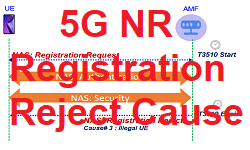5G NR Grant Free Dynamic Scheduling – Transmission without Grant
5G networks are expected to support applications demanding ultra-reliable and low latency communication services (URLLC). To support these kind of applications 5G-NR introduced grant free uplink transmission feature a.k.a. Transmission without grant (TWG). i.e. data transmission without resource request. Transmission without grant can avoid the regular handshake delay e.g. sending the scheduling request and waiting for UL grant allocation. Another advantage is that it can relax the stringent reliability requirements on control channels.
In 5G, PUSCH can be dynamically scheduled using following types of transmissions.
- UL grant in uplink DCI format DCI_0_0 or DCI_0_1
- UL grant in Random Access Response (RAR)
- Semi statically configured UL grant via RRC signalling
There are two types of Grant Free configuration schemes supported in 3GPP Release 15.
- TWG Type 1: Uplink grant configuration, activation/deactivation provided by RRC signalling
- TWG Type 2: Uplink grant configuration provided via RRC signalling and its activation/deactivation via PDCCH grant (via UL DCIs).

TWG Type 1
Type 1 is very much similar to LTE semi-persistent scheduling (SPS) where UL data transmission is based on RRC reconfiguration without any L1 signaling. RRC provides the grant configuration to UE through higher layer parameter named as ConfiguredGrantConfig including the parameter rrc- ConfiguredUplinkGrant without the detection of any UL grant in a DCI. Potentially SPS scheduling can provide the suitability for deterministic URLLC traffic pattern, because the traffic properties can be well matched by appropriate resource configuration.
TWG Type 2
In type 2 an additional L1 signaling (Downlink Control Indication) is introduced, where uplink is semi-persistently scheduled by an UL grant in a valid activation DCI. The Grant is activated and deactivated through DCI scrambled with CS-RNTI. RRC only provides the higher layer parameter ConfiguredGrantConfig not including rrc-ConfiguredUplinkGrant. The DCI signaling can enable fast modification of semi-persistently allocated resources. In this way, it enables the flexibility of UL Grant Free transmission in term of URLLC traffic properties for example packet arrival rate, number of UEs sharing the same resource pool and/or packet size.
Note: Both type 1 and type 2 are configured by RRC per Serving Cell and per BWP. For the same Serving Cell, the NR MAC entity is configured with either Type 1 or Type 2.
Scheduling Activation/Release Procedures
TWGTtype 1
There is no specific Activation/Release procedure is provided for TWG type1. RRC signalling with parameter ConfiguredGrantConfig including the parameter rrc-ConfiguredUplinkGrant implicitly mean TWG type 1 is activation. Also, for release no dedicated Information Element (IE) is sent by network, in order to release the TWG scheduling configuration network just send RRC reconfiguration release to UE.
TWG Type 2
TWG type 2 scheduling activation or scheduling release happens via PDCCH decoded DCIs if
- The CRC of a corresponding DCI format is scrambled with CS-RNTI and
- The new data indicator field for the enabled transport block is set to “0”.
Validation of the DCI format is achieved if all fields for the DCI format are set according to special fields for UL grant type 2 scheduling activation or scheduling release. If validation is achieved, UE consider the information in the DCI format as valid activation or valid release of configured UL grant type 2.
Article Submitted By:
Vikash Kumar
Related Post:
- 5G NR Control Plane Latency
- 5G NR User Plane Latency
- 5G Reference Network Architecture
- 5G Network Sharing: Concept, Benefits and Architectures
- Hybrid Core Network – 4G Core to 5 G Core Interconnection



